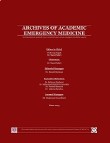Diagnostic and Prognostic Values of S100B versus Neuron Specific Enolase for Traumatic Brain Injury; a Systematic Review and Meta-analysis
Traumatic brain injury (TBI) represents a significant global health burden. This systematic review delves into the comparison of S100B and Neuron-Specific Enolase (NSE) regarding their diagnostic and prognostic accuracy in TBI within the adult population.
Conducted on October 21, 2023, the search identified 24 studies encompassing 6454 adult patients. QUADAS-2 and QUAPAS tools were employed to assess the risk of bias. The analyses aimed to evaluate the diagnostic and prognostic performance of S100B and NSE based on sensitivity, specificity, and area under the curve (AUC). The outcomes were detecting intracranial injury, mortality, and unfavorable outcome.
Pooled data analysis tended towards favoring S100B for diagnostic and prognostic purposes. S100B exhibited a diagnostic AUC of 0.74 (95% confidence interval (CI): 0.70-0.78), sensitivity of 80% (95% CI: 63%-90%), and specificity of 59% (95% CI: 45%-72%), outperforming NSE with an AUC of 0.66 (95% CI: 0.61–0.70), sensitivity of 74% (95% CI: 53%-88%), and specificity of 46% (95% CI: 24%-69%). Notably, both biomarkers demonstrated enhanced diagnostic value when blood samples were collected within 12 hours post-injury. The analyses also revealed the excellent diagnostic ability of S100B with a sensitivity of 99% (95% CI: 4%-100%) and a specificity of 76% (95% CI: 51%-91%) in mild TBI patients (AUC = 0.89 [0.86–0.91]). In predicting mortality, S100B showed a sensitivity of 90% (95% CI: 65%-98%) and specificity of 61% (95% CI: 39%-79%), slightly surpassing NSE's performance with a sensitivity of 88% (95% CI: 76%-95%) and specificity of 56% (95% CI: 47%-65%). For predicting unfavorable outcomes, S100B exhibited a sensitivity of 83% (95% CI: 74%-90%) and specificity of 51% (95% CI: 30%-72%), while NSE had a sensitivity of 80% (95% CI: 64%-90%) and specificity of 59% (95% CI: 46%-71%).
Although neither biomarker has shown promising diagnostic performance in detecting abnormal computed tomography (CT) findings, they have displayed acceptable outcome prediction capabilities, particularly with regard to mortality.
- حق عضویت دریافتی صرف حمایت از نشریات عضو و نگهداری، تکمیل و توسعه مگیران میشود.
- پرداخت حق اشتراک و دانلود مقالات اجازه بازنشر آن در سایر رسانههای چاپی و دیجیتال را به کاربر نمیدهد.


